Cooler Master Elite 120 Advanced Case Review: Little in Almost Every Way
by Dustin Sklavos on July 26, 2012 3:01 AM EST- Posted in
- Mini ITX
- Cases/Cooling/PSUs
- Cooler Master
Noise and Thermal Testing, Dedicated GPU
Cooler Master advertises the Elite 120 Advanced as being able to support the biggest, most powerful video cards on the market, and on one point that's true: there's certainly space inside the enclosure for them. The problem lies in keeping them cool; given how small a Mini-ITX case is, a large video card will essentially create its own thermal zone by virtue of its sheer size in relation to the rest of the chassis, so video cards are going to depend almost entirely on the side ventilation of the Elite 120 to feed their fans.
To test Cooler Master's claims, though, I ran the Elite 120 with both our usual Mini-ITX card, the Zotac GeForce GTS 450 Eco, and with our bigger ASUS GeForce GTX 560 Ti from our ATX/Micro-ATX testbed.
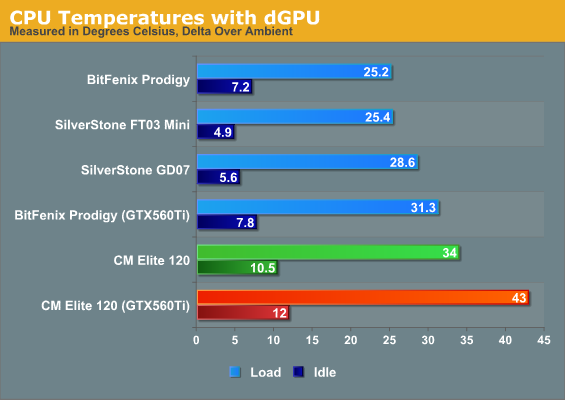
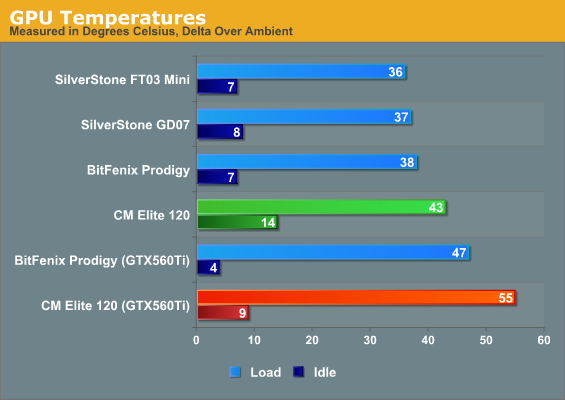
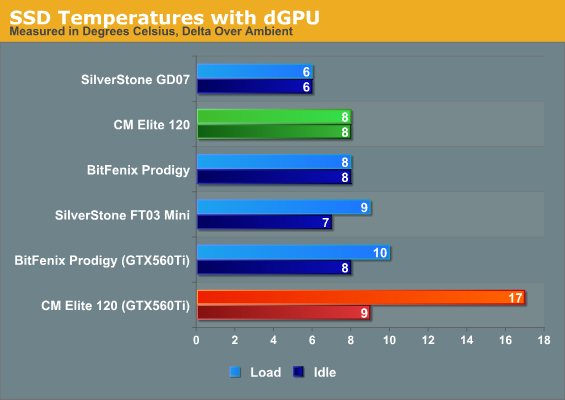
In the most technical sense, the Elite 120 certainly supports higher performance graphics cards, but I'd really hesitate to put anything faster than the GTX 560 Ti in this case. The sheer length of it seems to trap heat inside the drive cage, ramping up the temperature of our SSD. Our CPU also has a harder time staying cool due to the heat radiating off of the back of the video card.
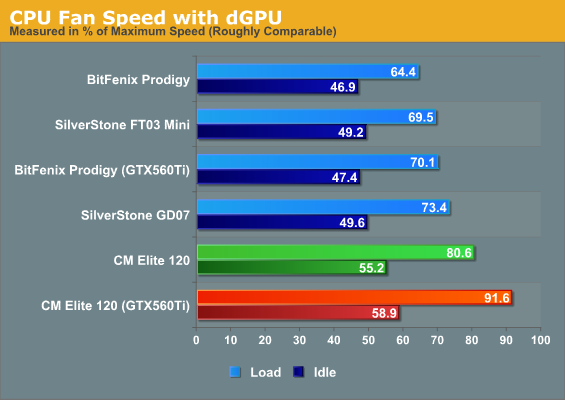
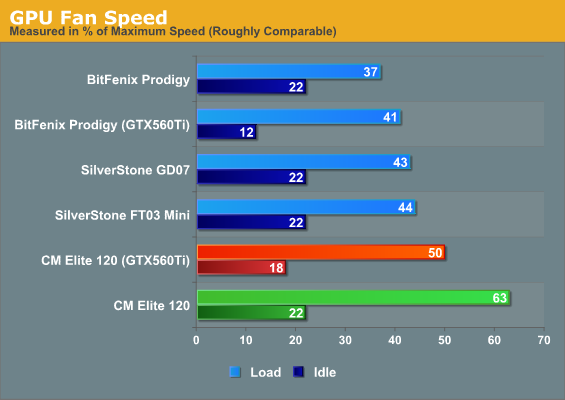
This is the first time I've seen the Mini-ITX testbed's cooler pushed to its limit. You can fit a GTX 560 Ti in the case, but it will overwhelm the cooling system. If you want a card like that in a Mini-ITX build you're going to have to move up to a BitFenix Prodigy.
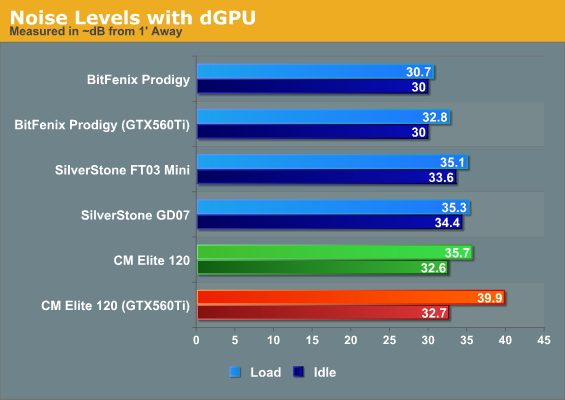
With all the fans cranking away as hard as they can the Elite 120's noise profile doesn't improve, either. At the risk of sounding like a broken record, anything more than a PCIe-slot powered video card is probably going to push this case too hard.










65 Comments
View All Comments
Beaver M. - Thursday, July 26, 2012 - link
Gigabyte and MSI still havent released new ITX boards, so I dont know how you can say that ITX is going anywhere...Death666Angel - Thursday, July 26, 2012 - link
Asrock, Asus, Zotac and Intel all have ITX mainboards with 1155 socket. You can choose from a total of 8 boards.Beaver M. - Thursday, July 26, 2012 - link
You dont get what Im saying.There are 2 big manufacturers that dont have ANY recent ITX boards and have actually discontinued all or almost all of their old ones. Remember how much ITX boards there were last year at this time? FAR more. Even Intel had several H67s and H61s. Asus had 2 H67, H61s, Biostar, Foxconn, Gigabyte, MSI, etc, etc.
Last year I would have agreed on a phrase like this, but not anymore.
Hell, they even offer more high end mainboards for $300+, that nobody buys, than ITX boards.
robinthakur - Thursday, July 26, 2012 - link
I'm also waiting on a decent gigabyte ITX to use for a Hackintosh, so would like to know when they are going to release one!Jeppeth - Thursday, July 26, 2012 - link
Did you really mount the PSU with the fan facing up? The PSU fan has to fight natural convection and can't really help in evacuating hot air from the case. Maybe this could explain why the case did so poorly.Menty - Thursday, July 26, 2012 - link
I have to agree with this :/ surely the fan in the PSU is better off pulling warm air from around the motherboard rather than staring into the sky?JPForums - Thursday, July 26, 2012 - link
Fighting natural convection isn't really a big deal with forced airflow. The air is cool going in and by the time it is heated, the high pressure from the intake fan is far more influential than natural convection. Just don't put it in a place where it is likely to suck in its own exhaust. Given a 120mm + 80mm intake and no forced exhaust, it is possible that pulling from the inside of the case may facilitate better airflow and lower case temperatures. However, the 80mm side fan provides fresh air directly (if less than ideally) to the CPU. The PSU fan may actually harm CPU temperatures by pulling air away from the CPU. The video card would have even less air directed at it. Ironically, it may actually work better in such a setup to cover most of the exhaust holes on the sides such that airflow is forced towards the GPU and PSU. It doesn't look like the case facilitates it, but moving the 80mm to the other side might actually be an overall improvement for setups with a PSU pulling from the inside. Fans wouldn't fight (as much), it would keep dGPUs cooler when present, and I can't see it being any worse on the CPU when a dGPU isn't present. Of course, the PSU's temperatures will undoubtedly rise in any setup pulling hotter air from inside the case, but it may not be that bad if the case temperatures drop significantly as a result.Nukemaster - Saturday, July 28, 2012 - link
I would tend to agree with this, My SG05 temps are better with the PSU fan facing down.Even got a cpu heatsink the blows up towards the psu later.
Dustin Sklavos - Sunday, July 29, 2012 - link
JPForums actually has it right on the mark, you grossly overestimate the importance of natural convection. If you look at SilverStone's rotated enclosure designs, they'll advertise that natural convection is part of what makes them work but testing on other sites has essentially debunked that: what makes them work is the fact that the fans (at least in the FT02) have a straight shot into the hardware. SilverStone's Temjin TJ08-E operates with the PSU flipped at the top in the same fashion, and it works just fine.Iketh - Sunday, July 29, 2012 - link
Natural convection... you don't realize how minor that force is...And why would you want 2 fans fighting for the same air?
That being said, I'd buy this case only to have the PSU sucking air from inside with a fanless CPU cooler...